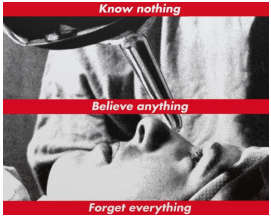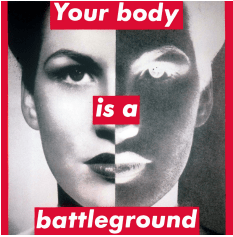Chloe Rounce 1
Barbara Kruger
Artists’ work like Andy Warhol, Cindy Sherman, and Sigmar Polke belong in a movement that emerged in the middle to late 1900s called Postmodernism. It was a movement that was generally characterized with certain themes of iconicity and self-awareness while drifting away from anti-capitalism and towards consumerism, individualism, and lowbrow or mass-consumed culture. Because of these new changes brought by the movement, particularly in art, media, and pop music, I was always attracted to how drastically it changed from modernism. Unlike modernists’ desire to answer the constant question of what is ___, Postmodernists distanced themselves from such subject matter. Barbara Kruger, a designer/photographer/artist, explored critique on society politically, socially, or otherwise through her use of satirical graphics.
What is initially striking about Kruger’s work– or at least for me– was her repetition in the use of red with black and white images and a specific type-face. Her style, like Warhol, is easily recognizable, which strengthens her statements about political or feminist issues. When I see her pieces, I feel overwhelmed by an opinion or idea that sounds loud– not to say that I disagree with her commentary. If anything, I love how her work acts fearless and lacks any sort of self-questioning or anxiety. The pieces seem derived from quotes she has said or heard, which she boldly translates into a physical thing. Being an artist myself, I know that creating a voice in each piece can be challenging.
 In a time of suspicion, Reaganomics, the emergence of pop music as a protest, and questioning of women and LGBTQ+ people’s rights, Kruger’s prints, posters, photographs, t-shirts, billboards, and more broadcasted directed phrases or quotes about themes of desire and consumerism.1In one work, Untitled (Know nothing, Believe anything, Forget everything), she uses imagery of a passive woman against text that reads “Know nothing, Believe anything, Forget everything,” which creates a lot of tension.2 There isn’t a secretive or underlying way that Kruger addresses the topics she always depicts. One thing that can be so characteristic of her work and different to many artists is how obvious her thoughts are. I’m envious of how she lacks a cloak of overdone symbolism or quiet statements. She sort of makes a choice and just does it because she wants the message to be out into the world. Kruger’s creations could be easily seen anywhere and printed into consumable media, like products/items or on signs that thousands of people passed by everyday. Could you imagine driving to work and seeing a statement considered so questionable for the culture in America at the time?
In a time of suspicion, Reaganomics, the emergence of pop music as a protest, and questioning of women and LGBTQ+ people’s rights, Kruger’s prints, posters, photographs, t-shirts, billboards, and more broadcasted directed phrases or quotes about themes of desire and consumerism.1In one work, Untitled (Know nothing, Believe anything, Forget everything), she uses imagery of a passive woman against text that reads “Know nothing, Believe anything, Forget everything,” which creates a lot of tension.2 There isn’t a secretive or underlying way that Kruger addresses the topics she always depicts. One thing that can be so characteristic of her work and different to many artists is how obvious her thoughts are. I’m envious of how she lacks a cloak of overdone symbolism or quiet statements. She sort of makes a choice and just does it because she wants the message to be out into the world. Kruger’s creations could be easily seen anywhere and printed into consumable media, like products/items or on signs that thousands of people passed by everyday. Could you imagine driving to work and seeing a statement considered so questionable for the culture in America at the time?
One of Kruger’s most famous works, Untitled (Your Body is a Battleground), she continued to explore feminism regarding reproductive rights. This piece of a woman’s face split into two images, one x-ray and one black and white, uses her iconic text. Kruger created this piece for the Women’s March on Washington in the eighties amidst antiabortion laws like Roe v Wade being up in the air on their establishment as legal. This piece is able to explain itself with the text included “Your Body is a Battleground,” which references the struggle for women to have rights over their bodies in multiple ways, particularly making medical decisions. She utilized her work as a way to send messages in a more accessible way to the public, which is respectable as an artist. Like other postmodernists, she was heavily involved in mass media and her messages brought much controversy. Her work became an act of support for thousands of women, which is one reason I was so drawn to her among the other artists of the postmodern era. There is more purpose to her exploration of consumerism.
This piece of a woman’s face split into two images, one x-ray and one black and white, uses her iconic text. Kruger created this piece for the Women’s March on Washington in the eighties amidst antiabortion laws like Roe v Wade being up in the air on their establishment as legal. This piece is able to explain itself with the text included “Your Body is a Battleground,” which references the struggle for women to have rights over their bodies in multiple ways, particularly making medical decisions. She utilized her work as a way to send messages in a more accessible way to the public, which is respectable as an artist. Like other postmodernists, she was heavily involved in mass media and her messages brought much controversy. Her work became an act of support for thousands of women, which is one reason I was so drawn to her among the other artists of the postmodern era. There is more purpose to her exploration of consumerism.
- “Barbara Kruger.” Barbara Kruger – 162 Artworks, Bio & Shows on Artsy,
www.artsy.net/artist/barbara-kruger.
- In the Tower: Barbara Kruger, www.nga.gov/press/exh/4708.html.
Though postmodernism was quite a few years ago in its prime, Kruger’s work still makes a strong statement in today’s political and social climate. Issues surrounding feminism and abortion are currently making headlines and it can be important to revisit important artists– activists even– like Barbara Kruger and use her work in repeating the message that is still being spread.
- “Barbara Kruger.” Barbara Kruger – 162 Artworks, Bio & Shows on Artsy,
www.artsy.net/artist/barbara-kruger.
- In the Tower: Barbara Kruger, www.nga.gov/press/exh/4708.html.